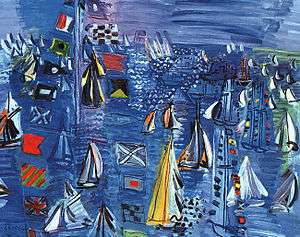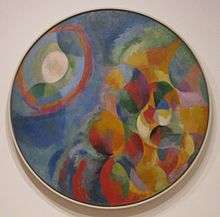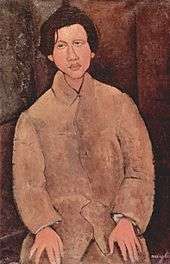School of Paris

School of Paris (French: École de Paris) refers to three distinct groups of artists: a group of medieval manuscript illuminators; a group of French and non-French artists working in Paris before World War I; and a group of both French and non-French artists living in Paris between the two world wars and beyond.
Medieval illuminators
The School of Paris also refers to the many manuscript illuminators, whose identities are mostly unknown, who made Paris an internationally important centre of illumination throughout the Romanesque and Gothic periods of the Middle Ages, and for some time into the Renaissance. The most famous of these artists were Jean Pucelle and Jean Fouquet. The Limbourg brothers, originally from the Netherlands, also spent time in Paris, as well as Burgundy and Bourges, but their style is not typical of the Paris of the day. Many of the painters in Parisian workshops were women.
Modern School of Paris

The School of Paris describes, not any one art movement or an institution, but is indicative of the importance of Paris as a center of Western art in the early decades of the 20th century. Between 1900 and 1940 the city became a magnet for artists from all over the world and a centre for artistic activity. School of Paris was used to describe this broad affiliation, particularly of non-French artists.[1]
The group of non-French artists in Paris before World War I created in the styles of Post-Impressionism, Cubism, Fauvism, and included artists like Pablo Picasso, Marc Chagall, Amedeo Modigliani and Piet Mondrian. French artists included Pierre Bonnard, Henri Matisse, Jean Metzinger and Albert Gleizes. Picasso and Matisse have been described as the twin chiefs (chefs d’école) of the School.[2]
Many of these same artists, plus Jean Arp, Robert Delaunay, Sonia Delaunay, Joan Miró, Constantin Brâncuși, Raoul Dufy, Tsuguharu Foujita, Emmanuel Mané-Katz; the Artists from Belarus, including Chaim Soutine, Michel Kikoine, Pinchus Kremegne, Ossip Zadkine, Jacques Lipchitz; the Russian prince born in Saint Petersburg Alexis Arapoff, Polish artist Marek Szwarc and others worked in Paris between World War I and World War II, in various styles including Surrealism and Dada. A significant group of Jewish artists working together came to be known as the Jewish School of Paris. This group included Mané-Katz, Soutine, Adolphe Féder, Marc Chagall, Moise Kisling, and Jules Pascin.[3]
In the same period, the School of Paris denomination was also extended to an informal grouping of classical composers that centered on musicians who had emigrated from Central and Eastern European and were now working in Paris. Composers who were prominently cited as members included Alexander Tansman, Alexander Tcherepnin, Bohuslav Martinů and Tibor Harsányi. Their preferred meeting place was the Café Du Dôme in Montparnasse. Unlike Les Six, this loosely-knit group did not seek to adhere to any particular stylistic orientation.[4]
After the Second World War the term School of Paris often referred to Tachisme, Lyrical Abstraction, the European parallel to American abstract expressionism and those artists are also related to Cobra. Important proponents were Jean Dubuffet, Zoran Music, Pierre Soulages, Nicolas de Staël, Hans Hartung, Serge Poliakoff, Bram van Velde, Georges Mathieu, Jean Messagier, among others. Many of their exhibitions took place at the Galerie de France in Paris, and then at the Salon de Mai.
Gallery
%2C_oil_on_canvas%2C_44.8_x_36.8_cm%2C_Korban_Art_Foundation..jpg) Jean Metzinger, c.1906, Femme au Chapeau (Woman with a Hat), oil on canvas, 44.8 x 36.8 cm, Korban Art Foundation
Jean Metzinger, c.1906, Femme au Chapeau (Woman with a Hat), oil on canvas, 44.8 x 36.8 cm, Korban Art Foundation%2C_oil_on_canvas%2C_private_collection.jpg) Marc Chagall, 1912, Still-life (Nature morte), oil on canvas, private collection
Marc Chagall, 1912, Still-life (Nature morte), oil on canvas, private collection Robert Delaunay, Simultaneous Contrasts: Sun and Moon (1912–13), oil on canvas, The Museum of Modern Art, New York City
Robert Delaunay, Simultaneous Contrasts: Sun and Moon (1912–13), oil on canvas, The Museum of Modern Art, New York City Moïse Kisling, 1913, Nu sur un divan noir, oil on canvas, 97 x 130 cm, published in Montjoie! 1914
Moïse Kisling, 1913, Nu sur un divan noir, oil on canvas, 97 x 130 cm, published in Montjoie! 1914 Amedeo Modigliani, Portrait of Chaïm Soutine, (1916)
Amedeo Modigliani, Portrait of Chaïm Soutine, (1916) Amedeo Modigliani, Jacques and Berthe Lipchitz (1916)
Amedeo Modigliani, Jacques and Berthe Lipchitz (1916) Jacques Lipchitz, 1920, Portrait of Jean Cocteau
Jacques Lipchitz, 1920, Portrait of Jean Cocteau Marek Szwarc, Self Portrait, 1921 Oil on canvas 66 x 54 cm.
Marek Szwarc, Self Portrait, 1921 Oil on canvas 66 x 54 cm.
See also
References
- ↑ "School of Paris". Heilbrunn Timeline of Art History. The Metropolitan Museum of Art. Retrieved July 16, 2014.
- ↑ "Glossary of art terms: School of Paris". Tate Gallery. Retrieved July 16, 2014.
- ↑ Ehrlich, M. Avrum, ed. (2008). Encyclopedia of the Jewish Diaspora: Origins, Experiences, and Culture. 1. Santa Barbara, CA: ABC-CLIO. p. 829.
- ↑ Korabelʹnikova, Li͡udmila Zinovʹevna (2008). "European Destiny: The Paris School". Alexander Tcherepnin: The Saga of a Russian Emigré Composer. Indiana University Press. pp. 65–70. ISBN 0-253-34938-9.
Further reading
- West, Shearer (1996). The Bullfinch Guide to Art. UK: Bloomsbury Publishing. ISBN 978-0-8212-2137-2.
- Nieszawer, Nadine (2000). Peintres Juifs à Paris 1905-1939 (in French). Paris: Denoel. ISBN 978-2-207-25142-3.
External links
| Wikimedia Commons has media related to École de Paris. |
- (French) (English) Nadine Nieszawer's website, dedicated to the School of Paris 1905-1939 (includes many biographies)
- French illuminated manuscripts: late fourteenth to early sixteenth century - British Library
- The Second Spanish School of Paris
- Website for Jewish art of the School of Paris circle
- school-of-paris.org : community website open to any fan to Ecole de Paris in the world
- The School of Paris 1945 – 1965